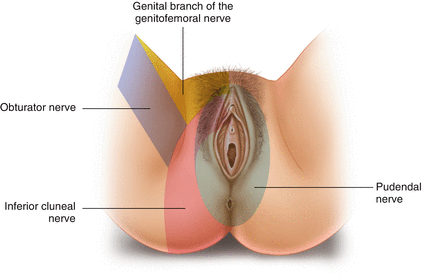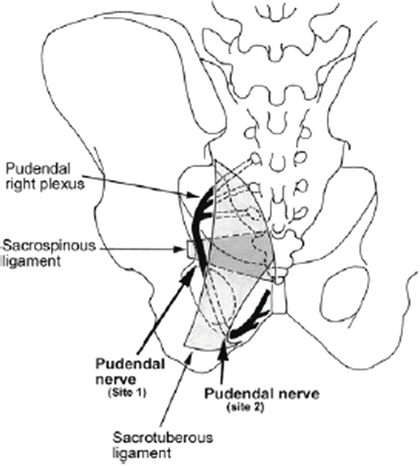Fig. 11.1.
Course of the pudendal nerve. Posterior, close-up view of the sacral region. Important anatomical landmarks such as ligaments and muscles are represented, illustrating the course of the pudendal nerve.
Throughout this chapter, the use of pudendal neuralgia will be referred to as a symptom, rather than as a diagnosis. Pudendal nerve entrapment is defined as compression of the pudendal nerve, typically by scar tissue or surgical material such as sutures or mesh products.
The true prevalence of pudendal neuralgia is unknown. The Portal for Rare Diseases and Orphan Drugs (orpha.net) estimates that 1–5 out of 10,000 patients have pudendal neuralgia, and of their population suffering from chronic pain, around 4 % have this condition.
Etiology: Types of Pudendal Neuralgia
Pudendal neuralgia is broadly defined. We define this as pain in the distribution of the pudendal nerve that can arise from a series of separate mechanisms (Fig. 11.2).


Fig. 11.2.
Dermatomal distribution of the perineum. (a) Pudendal nerve, (b) inferior cluneal nerve (or gluteal branch of posterior femoral cutaneous nerve), (c) obturator nerve, and (d) genital branch of the genitofemoral nerve and ilioinguinal nerve.
Pain that mimics pudendal nerve compression may be caused by pelvic floor muscle spasm. Since the pudendal nerves course through the pelvic floor muscles toward the surface of the skin, any muscle spasm that occurs in the pelvic floor can result in further compression of the nerve and severe pain. Causes of pelvic floor spasm include direct pelvic floor injury, other pain conditions in the pelvis, psychological influences, or idiopathic causes (Fig. 11.3) [2].


Fig. 11.3.
Posterior view of the pelvis shows the anatomical course of the pudendal nerve from a posterior view of the patient (from Kastler et al. [2], with kind permission of Springer Science + Business Media).
Pudendal nerve entrapment (PNE) is the direct result of pelvic trauma [3]. Causes of trauma can include surgery, childbirth, bicycle seats, sex, or athletic activities. Pelvic surgery is among the more common causes of PNE today.
Symptoms : What the Patient Experiences
Patients with pudendal neuralgia commonly describe their pain as a burning sensation in the region innervated by the pudendal nerve. Patients often state that the pain is exacerbated by sitting and improved with lying down [4]. The pain can be bilateral or unilateral. However, those with direct pudendal nerve injury tend to have unilateral pain.
It is important to appreciate that this pain is neuropathic in nature and often accompanied by significant allodynia and hyperesthesia. Common complaints or descriptions that arise during consultations include feelings of a foreign body sensation in the rectum or vagina, without an actual foreign body present (allotriesthesia). Depending on which branches of the nerve are involved, patients can experience pain with micturition, full/distended bladder, bowel movements, intercourse, or during an orgasm.
How to Diagnose Pudendal Neuralgia
Patient History
It is important to determine the events that preceded the symptoms for pudendal neuralgia as well as its progression. Many patients will present after traumatic injury to the pelvis with either gradual onset or immediate pain. Their pain is located in the area of innervation supplied by the pudendal nerve. It is neuropathic in nature and is exacerbated by sitting [4]. The gradual progression in pain for patients usually is minimal in the morning and progressively worsens throughout the activities of daily living, becoming most severe in the evening. Classically, most patients will note they have less pain sensation when sitting on the toilet seat in comparison to a chair.
Almost all patients with pudendal neuralgia have pain with intercourse and postcoital dyspareunia. Patients often state that it is so severe they will refrain from having intercourse altogether, which negatively affects their partners as well. Along with dyspareunia, common complaints also include pain with bowel movements, urination, or sexual arousal, as discussed above.
Physical Examination
The physical examination is extremely important in order to rule out other possible causes of pain. Common findings among patients with pudendal neuralgia include pelvic floor muscle spasm and pain on pelvic examination; therefore, it can be difficult to determine any underlying nerve injury until the spasms are treated [5]. Among patients with pudendal neuralgia, the physical examination should always confirm pain within the dermatome supplied by the pudendal nerve. In patients with pudendal nerve entrapment, there will be tenderness over the sacrospinous ligament just medial to the ischial spine. Palpation of this area precipitates a tingling sensation commonly known as Tinel’s sign.
Ancillary Testing
As noted in Table 11.1, pudendal nerve motor terminal latency (PNMTL ) testing may help determine nerve conduction and the integrity of the nerve [6]. Electrical impulses are applied transvaginally or transrectally using a pudendal electrode (St. Mark’s) on the tip of the examiner’s finger. Increased conduction time signifies damage to the nerve. It is a nonspecific test, as it does not determine the cause or the level of the injury. Also, the results of the study have been shown to have wide range, as the length of this nerve can be variable [7]. The value of this testing therefore remains controversial.
Test | How to perform | Comments |
|---|---|---|
Pudendal nerve motor terminal latency (PNMTL ) | Measures speed of impulse conduction between ischial spine and pelvic floor. Performed with St. Mark’s electrode | High inter- and intra-observer variability. Test unreliable due to inability to measure the length of pudendal nerve |
Quantitative sensory testing | Warm detection test—based on patient’s perception of change in temperature Two point discrimination test—based on patient’s ability to distinguish between one and two points | Used in diagnosis of other neuropathic conditions but not validated for pudendal nerve |
Magnetic resonance imaging (anatomic) | 1.5 and 3 T MR with specific pelvic floor protocols | Pudendal nerve smaller than resolution of MRI. Studies on normal subjects not done |
Magnetic resonance imaging (functional) | Magnetic resonance neurography—novel technique to enhance image of neurovascular bundle using water properties of the nerve | Studies on normal subjects not done |
Quantitative sensory threshold testing and mapping have been used for the diagnosis of other peripheral nerve disorders, but have not been validated for the pudendal nerve [8]. These tests gauge the ability to discern between hot and cold temperatures and also between two pressure points. Compressed nerves lose the ability of fine discrimination.
Magnetic resonance imaging (MRI ) of the pelvis is superior to other imaging modalities of the pelvis, as it can determine abnormalities of the muscles and soft tissue in great detail [9]. Higher resolution 3 T MRI can provide more detailed information along the pathway of the pudendal nerve, including scarring, inflammation, and entrapment. Magnetic resonance neurography (MRN) may also help identify the pudendal nerve along its pathway. Often the nerve is too small to be viewed accurately, unless it is grossly damaged and enlarged. In addition, MRN is typically performed in highly specialized centers, as it requires radiologists to be familiar with specific neuroanatomy to accurately interpret the images.
The Nantes Criteria
The Nantes Criteria for diagnosing pudendal nerve entrapment was established by Professor Roger Robert in Nantes, France. He is one of the pioneers of surgical treatment of pudendal neuralgia. Table 11.2 lists these criteria, which have been validated [10]. Patients who meet these criteria are more likely to respond positively to surgical options than those who partially meet these criteria.
Table 11.2.
Nantes criteria for the diagnosis of pudendal neuralgia (from Labat et al. [10], with kind permission of John Wiley & Sons).
Inclusion criteria |
•Pain in the area innervated by the pudendal nerve |
•Pain more severe with sitting |
•Pain does not awaken patient from sleep |
•Pain with no objective sensory impairment |
•Pain relieved by diagnostic pudendal block |
Exclusion criteria |
•Pain located exclusively in the coccygeal, gluteal, pubic, or hypogastric area (without pain in the area of distribution of pudendal nerve) |
•Pruritus |
•Pain exclusively paroxysmal |
•Abnormality on imaging (MRI, CT) which can account for pain |
Complementary criteria |
•Pain characteristics: burning, shooting, numbing |
•Allodynia or hyperesthesia |
•Allotriesthesia |
•Pain progressively throughout the day |
•Pain predominantly unilateral |
•Pain triggered by defecation |
•Significant tenderness around ischial spine |
•Abnormal neurophysiology testing (PNMTL) |
Associated signs |
•Buttock pain (around ischial tuberosity) |
•Referred sciatic pain |
•Pain referred to the medial side of the thigh |
•Suprapubic pain |
•Urinary frequency with full bladder |
•Pain after orgasm/ejaculation |
•Dyspareunia or pain after intercourse |
•Erectile dysfunction |
•Normal PNMTL |
Differential Diagnosis
Pelvic Floor Tension Myalgia (Also Called Levator Syndrome )
This is a diffuse spasm of pelvic floor muscles. Symptoms are associated with pain during and after intercourse [11]. Patients also report hesitancy and sensation of incomplete voiding. On pelvic examination, there are pelvic floor muscle spasms. This may be confirmed by urodynamic testing. Of note, pelvic floor muscle spasms are nonspecific findings that often present among patients with other painful conditions, including pudendal nerve entrapment, endometriosis, and even inguinal hernia .
Stay updated, free articles. Join our Telegram channel

Full access? Get Clinical Tree





